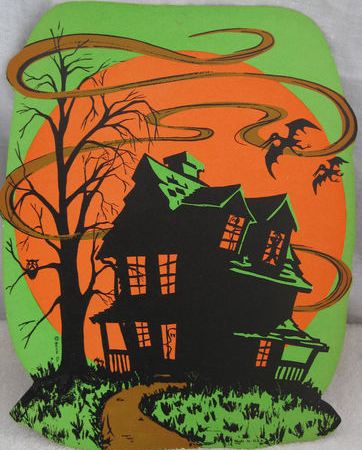This diecut is instructive as to some ways to quickly date when an item was manufactured. Typically, when you see these brighter diecut colors you can assume the item was made no earlier than the mid-1960s. The imagery, not too scary or challenging, is another clue to the item's age and leads one to the same conclusion as to time frame. Lastly, as this is a Beistle item, the mark used is the strongest clue. Beistle used this mark - and uses it to this day - beginning in the 1960s. The market for Halloween items manufactured beginning in the 1960s and forward is in its earliest stages. For those interested in this era of memorabilia, prices should slowly increase as items in collectible condition disappear into collections.
Blog
Have A Merry Christmas!!
As my long-time readers know, I typically take a break to recharge the old Halloween batteries during most of the month of December. With my newly re-designed site, I've been tinkering with a few things well past the typical date on which I walk away to focus on the Christmas season. I have made a few posts today, but don't plan on making any more until after New Year's Day. (Of course, if I see something I just can't help myself about, I may take a few minutes to post, but with the very low quality level and and avalanche of items being listed and re-listed on Ebay ad infinitum ad nauseum, there is a strong likelihood I'll not metaphorically take up my pen before several weeks have elapsed.)
A Vintage Halloween Minute with MBL - 10 Beistle Skeleton Die-cut
This is the tenth of a planned release of one dozen short videos. I will be releasing the final two videos of this set after the New Year. Enjoy!
A Vintage Halloween Minute with MBL - 09 Rosen Pops Box
This is the ninth of a planned release of one dozen short videos. I will be releasing the final two videos of this set after the New Year. Enjoy!
Halloween Cardboard 4-sided Lamp Cover
This lantern, made by Gibson in 1929, is quite scarce. I have only seen it for sale a handful of times in nearly 25 years. As I point out on page 45, this is a good example of how clever manufacturers would re-purpose imagery as a cost savings measure. The imagery of this lantern is nearly identical to Gibson's "Ring the Belle" game, also a scarce item. The ending price of $202.51 was pretty much where it should have ended taking its condition into account.
Vintage HALLOWEEN TAMBOURINE Noisemaker Witch Skeleton Black Cat Tin Litho
The seller was right in saying that this tambourine comes up infrequently. There were many pieces to this set, all made in the 1960s. Virtually all of the set can be easily found, but not this tambourine. Made by an unknown manufacturer, one of the quick ways to deduce its age is by the imagery. The cute and simplistic design screams, "I was made well past the heyday of the most coveted Halloween designs!" The price for this item was far stronger than I would have forecast, especially considering it wasn't perfect.
Old Halloween Noisemaker Bell with Witches
This particular tin litho design was made for many years by U.S. Metal Toy. One way to determine approximately when a noisemaker like this was made is by looking at the handle. This one has a plastic handle, which dates it to being made in the 1960s. All else being equal, the noisemakers with wood handles are worth more.
Mint - Very Rare 1930's German Paper Mache Skull Noise Maker
This skull horn, and the several others from this set of horns, was made in the mid-1990s. They first made their appearance at an antiques show in Atlantic City and have been plaguing our fine hobby since. They typically show up in boxes, six or so to the box. The boxes are actually old, and it is the age of the boxes that has fooled many dealers into thinking the contents, too, are old. The horns have decorative value only. Don't be fooled!
A Vintage Halloween Minute with MBL - 08 Cat and Witch Mechanicals
This is the eighth of a planned release of one dozen short videos. I will be releasing these over the next few weeks. Enjoy!
A Vintage Halloween Minute with MBL - 07 German Porcelain Tea set
This is the seventh of a planned release of one dozen short videos. I will be releasing these over the next few weeks. Enjoy!
Vintage HALLOWEEN Die-Cut DENNISON Arched Black Cat SILHOUETTES, Envelope
Halloween noisemaker
Old GERMANY Diecut WITCH Paddle Halloween Noisemaker
This seems to be a very good deal. There were a variety of these German diecut clapper items manufactured in the 1920s. Virtually all of them were painted in such a way that would denote wear to the untrained eye. (The way these were painted is identical to how a few diecuts like the owl in the middle of page 163 were painted.)
Here's A Fun Site...
I had the good fortune to be contacted by Tim Malik who has created an engaging site. I have included the link to it below. Be sure to check it out!
.A Vintage Halloween Minute with MBL - 06 Beistle Grandfather's clock invitation .
This is the sixth of a planned release of one dozen short videos. I will be releasing these over the next few weeks. Enjoy!













